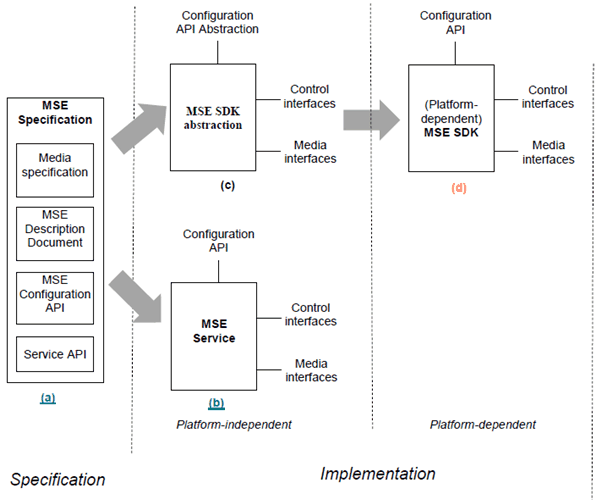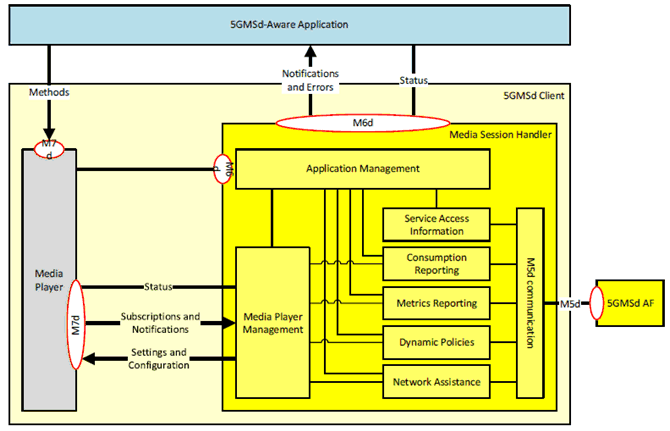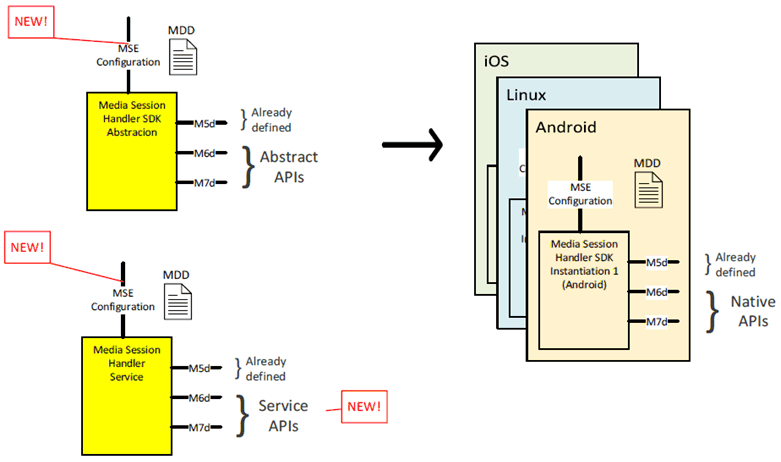Content for TR 26.857 Word version: 18.0.0
5 Considered MSE frameworks
5.1 General
5.2 MSE framework proposal #1
5.2.1 Architecture
5.2.2 MSE Specification
5.2.3 MSE implementation
5.2.4 Example
5.2.5 Benefits
...
...
5 Considered MSE frameworks p. 19
5.1 General p. 19
This clause collects some proposed and considered MSE frameworks. A discussion on the different framework proposals is provided in clause 5.4.
5.2 MSE framework proposal #1 p. 19
5.2.1 Architecture p. 19
Figure 4.4.1.1-1 shows a possible framework for Media Service Enablers. The MSE framework consists of two parts: the MSE specification (on the left of the figure) and the MSE implementation (on the right).

5.2.2 MSE Specification p. 20
An MSE Specification (a) defines:
-
Media aspects
- Functional description of the MSE including the mandatory and optional features.
- The control interfaces such as provisioning, authentication that is used by the application, and other functions to interact with this MSE.
- The media interfaces that includes all inputs and outputs format and protocols.
- Network interface including system and radio network.
- Event, notifications, reporting, and monitoring.
- Error handling.
-
MSE Configuration
-
An MSE Description Document (MDD) that describes an implementation's functional support in a standardised way, including:
- Functions supported by an MSE implementation and their configuration parameters.
- Optionally the performance/cost metrics for the different features/options.
-
An MSE Configuration API (MCA) abstraction for:
- Optionally retrieving the MSE Description Document.
- Configuring the MSE instantiation.
- Optionally retrieving the state and status of the MSE instantiation.
- A service API for the MSE Configuration API.
-
An MSE Description Document (MDD) that describes an implementation's functional support in a standardised way, including:
5.2.3 MSE implementation p. 20
An MSE implementation may consist of up to three aspects:
-
The MSE SDK abstraction (c), an abstract SDK definition intended to be realized as a Software Development Kit, which includes the followings:
- Media aspects conforming to the MSE specification.
- MSE Description Document and MSE Configuration API.
-
The MSE SDK instantiation (d) which is an SDK implementation in a specific environment and conforms to the following:
- Media aspects conforming to the MSE Specification.
- MSE Description Document and a specific implementation of the MSE Configuration API.
-
The MSE service (b) which is the MSE implementation as a service, i.e with APIs that are platform-independent (such as web-based APIs) and conforms to the following:
- Media aspects conforming to the MSE Specification.
- MSE Description Document and a platform-independent implementation of the MSE Configuration API.
| Feature | Specification
(a) |
MSE service
(b) |
MSE SDK abstract
(c) |
MSE SDK
(d) |
|---|---|---|---|---|
| MSE Description Document (MDD) | Describes the mandatory and optional features in a standard way. | Describes features implemented and configuration options using MDD. This document can be retrieved using MCA. | Describes features implemented and configuration options using MDD. This might be a side document. | Describes features implemented and configuration options using MDD. This might be a side document. |
| MSE Configuration API (MCA) | The API abstraction describing how to configure the MSE. | A platform-independent API for MSE configuration. | An abstract API for MSE configuration. | An API instance for MSE configuration. |
5.2.4 Example p. 22
As shown in Figure 5.2.1-1, the MSE Specification can be deployed in two different ways: as an SDK for running on devices or as a microservice running on an Application Server. To demonstrate converting an existing 3GPP specification to an MSE specification, we use the 5GMS Media Session Handler defined in TS 26.501, shown in Figure 5.2.4-1.


Figure 5.2.4-2: Media Session Handler as MSE SDK abstraction, MSE SDK instantiations, and MSE service
(⇒ copy of original 3GPP image)
(⇒ copy of original 3GPP image)
The MSE Specification for the Media Session Handler (MSH) shown in Figure 5.2.4-2 describes the following:
-
Media aspects:
-
Functional description of:
- Service Access Information.
- Consumption Reporting.
- Metrics Reporting.
- Dynamic policies.
- Network Assistance.
-
M5d, M6d, M7d API definitions:
- M5d as is already defined.
- M6d and M7d as abstract APIs.
- M6d and M7d as service APIs.
-
Functional description of:
-
MSE Configuration
-
An MSE Description Document which describes:
- An identifier that shows this MSE conforms to (1).
- Optional features of (1a) and (1b) with their configuration parameters.
- Optionally the performance/cost metrics for the different features/options.
-
Abstract API definitions for:
- Retrieving the MSE Description Document (2a).
- Configuring the MSE instantiation.
- Retrieving the state and status of the MSE instantiation.
- A service API for the abstract API (2b). And MSE SDK implementation of the above specification for Android should support the following:
-
An MSE Description Document which describes:
- Media aspects conforming to (1), including a specific implementation of the M6d and M7d service APIs.
- The MSE Description Document (2a) and a specific implementation of the abstract APIs (2b).
5.2.5 Benefits p. 24
The benefits of the above approach are the following:
- The MSE specification defines all mandatory and optional features in a single document, the MDD, with references to the specific relevant clause(s).
- The MSE specification also optionally defines the MSE Configuration APIs for managing and retrieving information from an implementation.
- An implementer can use the MSE specification's MDD as a feature checklist.
- An implementer can use the MSE Configuration API to implement the API for MSE services.
- The SDK instantiation of an MSE specification includes a side MDD describing the features supported by the SDK and the optional configurations it may have.
- The MSE service instantiation of an MSE specification includes an MSE configuration API conforming to the one defined in the MSE specification that can be used for retrieving and configuring the service.
- The MSE service instantiation provides an MDD (as a side or as part of retrieval through MSE configuration API) that provides the supported features of the MSE service instantiation.